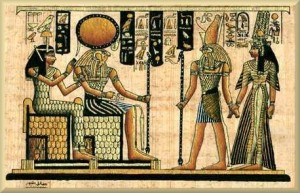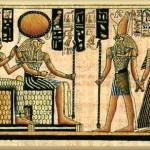 Various accounts of the Egyptian Book of the Dead state that Horus was a god before he became a man, and that when he was born of the virgin Isis on December 25 in a cave, his birth was announced by a star in the East to three wise men, after which he was carried to Egypt to escape the wrath of the local king.
Various accounts of the Egyptian Book of the Dead state that Horus was a god before he became a man, and that when he was born of the virgin Isis on December 25 in a cave, his birth was announced by a star in the East to three wise men, after which he was carried to Egypt to escape the wrath of the local king.
When he was thirty, Horus was baptized by Anup the Baptizer before gathering twelve disciples and traveling around the countryside teaching and performing miracles like feeding bread to a multitude and walking on water. Finally, he was crucified, buried in a tomb, and later resurrected from the dead.
All of this was written many thousands of years before Jesus ever lived and died. I’ve written about all of this previously, showing that even if these parallels are true, they do not disprove the historical reliability of the Gospels.
But there is more.
Parallel stories in ancient myths do not mean that the Gospel accounts of Jesus are false. It may be just the contrary, that God purposefully chose some of the greatest dreams and desires of all mankind, and in Jesus, made them reality.
This may be one of the greatest truths of the incarnation. It is not just that God became flesh, but that God put into Jesus all of mankind’s greatest dreams and desires. To keep it “orthodox” we might say that even those dreams and desires came from God.
But is such an idea so strange? Can we not imaging that God, both in looking over history through foreknowledge and in creating humankind, put into Jesus the same sort of hopes, dreams, tales and ideas that would fascinate and hold captive the thoughts and hearts of men? Why could it not be so?
When people look for the manifestation of God, they need look no further than their own heart and mind. This is not to say that we are all god. But it would not be wrong to argue that in many ways, we are all God’s. Movies, music, and art all point to the grandeur and majesty of God, even if they first point to the creativity of men. Fiction becomes reality and dreams come to life when the invisible God makes Himself known.
It is as G. K. Chesterton wrote in The Everlasting Man:
The populace have been wrong in many things; but they have not been wrong in believing that holy things could have a habitation and that divinity need not disdain the limits of time and space.




Jeremy,
I have read that this account is actually later than Christ and thus is a rip-off of the gospels.
Antonio
Antonio,
Good to hear from you!
Well, the Egyptian Book of the Dead clearly predates the gospels. It is found as hieroglyphics on the walls of old tombs. One approach, however, argues that the parallels I summarized above do not actually exist.
But even without the exact details I listed above, there are parallels in ideas and themes from old pagan myths and themes found in the Gospels.
it reminds me of this book from Don Richardson
a very good book
Tommy,
You are right! I’ve read that book, and that is very similar to what Don Richardson found in the jungles. Thanks for the reminder.
My favorite lines in Christian hymns are the ones such as “come, desire of nations, come”. They speak of the deep longing for God and an even deeper “knowing” of the Story that I do believe God has woven deep into our psyches. The gospel themes are echoed in many stories around the world. 🙂
Ellen,
You are absolutely right! You know, I never noticed that line in the Hymn. But from now on, it has so much more significance and meaning. Thanks for pointing that out.
Also, thanks for commenting. It led me to your blog, and I love what you are writing there. I’m adding you to my Google Reader.
Jeremy, I found myself nodding and saying “yes” as I read your post. Yes, God could put into Jesus the hopes, dreams, desires of humans throughout history and use those things to reveal himself. I find that God uses stuff in my own life – stuff I believe, stuff I do, stuff I think – to reveal things to me all the time. Jesus used ideas and illustrations that people were familiar with to teach when he was on earth. It makes sense!
The whole spirit of your post reminded me of a quote by Thomas Merton that I used in a post recently. Here it is:
“We are living in a world that is absolutely transparent
and God is shining through it all the time.
God manifests Himself everywhere, in everything – in
people and in things and in nature and in events …
The only thing is we don’t see it …
I have no program for this seeing. It is only given.
But the gate of heaven is everywhere.”
Liz,
That’s a good quote by Merton. It is so true: “the only thing is we don’t see it.”
I like the quote from Chesterton – havent read that nook, but must put it on my “to read” list!
Steve,
If you like C. S. Lewis, you will like Chesterton. Lewis says that Orthodoxy and The Everlasting Man were two of the most influential books in his thinking and writing.
Somewhere in The Everlasting Man, Chesterton writes about God being the original cave man (He’s speaking about Jesus being born in a cave). I love it!
jeremy, thanks for this. i resonated with the idea of God’s image being reflected in so many wild and beautiful ways that are far beyond the limits we can put on it.
Kathy,
I love what you are doing at The Refuge. It makes me wish I lived in the Denver area.
I make it out there for training a few times a year. Maybe next time I’m out there, I can meet with one of the houses of refuge?
hey jeremy, i just saw your comment on michelle’s post and thought i’d pop back over here. of course, would love to hang out if you come to denver, just lmk. you can email me. we have a weekday house of refuge on wednesdays at our house & our weekend gathering is saturday night. peace, kathy
Or, a more realistic answer could be that Abrahamic religions simply stole their ideas from older religions.